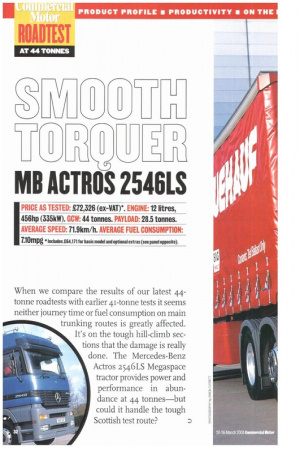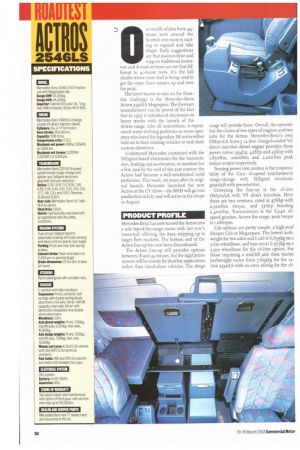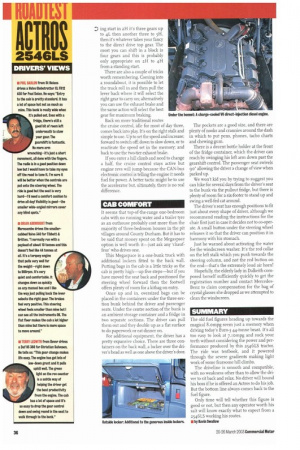Mil ACTROS 2546LS
Page 32

Page 34

Page 35

Page 36

If you've noticed an error in this article please click here to report it so we can fix it.
IRICE AS TESTED: £72,326 (ex-VAT)*. ENGINE: 12 litres, 456hp (335kW). GCW: 44 tonnes. PAYLOAD: 28.5 tonnes. AVERAGE SPEED: 71.9km/h. AVERAGE FUEL CONSUMPTION: 7:10mpg • Includes 164,171 for basic model and optional extras (see panel opposite).
When we compare the results of our latest 44tonne roadtests with earlier 41-tonne tests it seems neither journey time or fuel consumption on main trunking routes is greatly affected. It's on the tough hill-climb sections that the damage is really done. The Mercedes-Benz Actros 2546LS Megaspace
tractor provides power and
performance in abun
dance at 44 tonnes—but could it handle the tough Scottish test route?
ur wealth of data from 44tonne tests around the Scottish test route is starting to expand and take shape. Early suggestions are that journey time and mpg on traditional motorway and A-road sections are not that different to 41-tonne tests. It's the hill climbs where more fuel is being used to get the extra three tonnes up and over the peak.
The latest tractor to take on the threeday challenge is the Mercedes-Benz Actros 2546LS Megaspace. The German manufacturer can be proud of the fact that in 1997 it introduced electronics to heavy trucks with the launch of the Actros range. Like all innovations, it experienced some teething problems as some operators who loved the legendary SK series either held on to their existing vehicles or took their custom elsewhere.
Undeterred Mercedes continued with the Telligent-based electronics for the transmission, braking and acceleration, to mention but a few, and by the end of the 21st century the Actros had become a well-established solid performer. This week, six years after its original launch, Mercedes launched the new Actros at the CV show—the RHD will go into production in July, and will arrive in the shops in August.
PRODUCT PROFILE
Mercedes-Benz has now turned the Adios into a sole top-of-the-range motor with last year's lower-tech offering, the Axor, stepping up to target fleet markets. The bottom end of the Actros line-up has now been discontinued.
The Actros line-up still provides options between 18 and 44 tonnes, but the rigid prime movers will be mainly for drawbar applications rather than stand-alone vehicles. The Atego
range will provide those. Overall, the operator has the choice of two types of engines and two cabs for the Actros. Mercedes-Benz's own 0M5or LA Euro-3 i2-litre charged-cooled V6 direct injection diesel engine provides three power ratios; 394hp, 428hp and 456hp with 1,85oNm, 2000Nm and 2,200Nm peak torque output respectively.
Turning power into motion is the responsibility of the G2Il 16-speed synchromesh range-change with Telligent electronic gearshift with pre-selection.
Crowning the line-up is the 16-litre 0M5o2LA with V8 direct injection. Here there are two versions, rated at 476hp with 2,300Nm torque, and 53ohp boasting 2,400Nm. Transmission is the G24o i6speed gearbox. Across the range, peak torque is 1,o8orpm.
Cab options are pretty simple. a high-roof Sleeper Cab or Megaspace. The lowest kerbweight for two axles and L cab is 6,695kg on a 3.6m wheelbase, and tops out at 6,975kg on a 3.9m wheelbase for the 16-litre option. For those requiring a mid-lift axle then tractor kerbweight varies from 7,695kg for the 12litre 254oLS with an extra 260kg for the i6
litre Actros. The Megaspace cab adds 230kg, all on the front axle. The V8 versions also get the option of the allsinging, all-dancing Executive Megaspace.
Commercial Motor's test vehicle is the 2546LS with mid-lift powered by the 456hp engine. Optional extras fitted include the sat-nay system, two very different seats, alloy wheels, and remote central locking with automatic window closing. The metallic paint job is an option. as is the air horn and air management kit. All this costs £8,155 (ex-VAT) and coupled with the f64,171 basic asking price for the tractor totals £72,326 (ex-VAT).
And what will your Actros 2,546LS Megaspace be expected to fetch in three years' time? According to Cap Network Commercial Vehicle Monitor, it will be worth /26,80o—i3,500 less than the Volvo FHT2 Globetrotter XL. If you select a fleet-oriented tractor then the Daf CF85.43o 6xz is worth less, but the Scania R124 420 pusher enjoys a good residual value and is worth £28,100 after three years.
Despite a chilled February with the temperature never rising above 5°C, it proved to be as near to perfect test weather as we could hope for. Clear skies with next-to-no wind coming from the south-east, coupled with pretty clear roads combined to make ideal testing conditions.
The overall biel consumption figure for the Actros 2546LS is 7.1 ompg. At 44 tonnes, figures in the high sevens achieved at 41 tonnes could well prove a thing of the past on this Scottish route. Overall time and performance for the test was not overly affected and on the trunlcing routes it matched previous 41-tonne tests, but hauling an extra three tonnes over the mountains on the A68 did incur a fuel penalty.
The Volvo FHI2 460 roadtest at 44 tonnes (CM 27 Feb-5 March) returned 7.05mpg—it used more fuel over the easy A-roads and tough motorway section, while matching the 2546LS over the severe gradients.
So far, the early 44-tonne tests have shown that it's the less powerful tractors that are leading the way, undermining the industry's rohp/tonne preference. The Scania RII4 420 produced 7.5impg while the Daf CF85.43o returned a leading 7.69mpg.
Of course, for operators, fuel is king but it is worth considering how a lower-rated engine would cope day in, day out hauling 44 tonnes. Significantly the 2546LS was quicker than the Daf, Scania and Volvo over the A-roads and motorway, and matched its peers over the
severe gradients. So getting the load delivered on time shouldn't be a problem.
In terms of payload, the Actros loses around 400 to 500kg against the Volvo and Daf respectively, but is up 2.8 tonnes on the 2543LS which was tested at 41 tonnes and Euro-3 (CM 26 Jul-i Aug 2001).
ON THE ROAD
On the open road and trunlcing routes, it carried 44 tonnes effortlessly. If anything, on the route to Hamilton Services in Glasgow with the 456hp we were more likely to change down to provide revs for the butterfly engine brake rather than to help it over the peaks on the motorway. We were able to lug down from 56mph at 1,488rpm to just above 4omph at L000rprn without changing gear.
As motorways, dual carriageways, and bypasses gave way to Dalkeith and the A68, the power from the V6 held true, keeping a fair rate of knots as
we headed back south. Previous tests at 44 tonnes have seen plenty of roll from a hill but travelling up has been a different story—it's a slog. We have even glanced down before now to see if the hand brake has been left on, as the momentum disappears and the bill drags right out.
The true testament to the power of the
2546LS came on three sharp hill climbs aftc we had motored up Carter Bar First, we dro to 30mph into West Woodburn before craw ing out the other side contemplating manoeuvre down the box into the bottor half. This is swiftly followed by the descent t a 90° right turn before dragging ourselves u through the one-pub village of Ridsdale, itse boasting a sharp incline with part of the roa covered in tyre marks where previous truck have ground to a halt. Finally we climbe Castleside, starting in 5L after negotiating tra fic lights just before the bridge and the shar rise into the village.
It was with some contentment that w turned left out of Castleside towards Conse as, even at 44 tonnes, with 456hp under th floor we didn't drop into the bottom half of th box. That's some achievement.
The Mercedes-Benz Telligent gearbox prc vides a simple and effective way of gea changing. Out go the worries about gettin the range-change right or forgetting whethe you are in High or Low on an H-pattern an accidentally jumping three gears when yo. only aimed for one or two.
Here it's pre-selection; a nudge forward fa two on the main gear stick, or two up on th paddle at the front does the job. All bloc changes can be done on the top control but fo versatility you need the paddle. From a stanc
ing start in 2H it's three gears up to 4L then another three to 5H, then its whatever takes your fancy to the direct drive top gear. The most you can shift in a block is four gears and this is probably only appropriate on 2H to 4H from a standing start.
There are also a couple of tricks worth remembering. Coming into a roundabout, it is possible to let the truck roll in and then pull the lever back where it will select the right gear to carry on; alternatively you can use the exhaust brake and the same action will select the best gear for maximum braking.
Back on more traditional routes the cruise control, idle for most of day three, comes back into play. It's on the right stalk and simple to use. Up to set the speed and increase; forward to switch off, down to slow down, or to reactivate the speed set in the memory; and back to use the two-tier exhaust brake.
If you enter a hill climb and need to change a half, the cruise control stays active but engine revs will jump because the CAN-bus electronic control is telling the engine it needs fuel for power. A better tactic might be to use the accelerator but, ultimately, there is no real difference.
CAB COMFORT
It seems that top-of-the-range one-bedroom cabs with no running water and a trailer tyre as an outhouse probably cost more than the majority of three-bedroom houses in the pit villages around County Durham. But it has to be said that money spent on the Megaspace option is well worth it—just ask any 'chauffeur' who drives one.
This Megaspace is a one-bunk truck with additional lockers fitted to the back wall. Putting bags in the cab is a little tricky as the cab is pretty high—up five steps—but if you have moved the seat back and positioned the steering wheel forward then the footwell offers plenty of room for a kitbag on entry.
Once up and in, oversized bags can be placed in the containers under the three-section bunk behind the driver and passenger seats. Under the centre section of the bunk is an ambient storage container and a fridge in two separate sections. The driver can pull them out and they double up as a flat surface to do paperwork or eat dinner on.
For additional equipment, the driver has a pretty expansive choice. There are three containers on the back wall, a locker over the driver's head as well as one above the driver's door. The pockets are a good size, and there are plenty of nooks and crannies around the dash in which to put pens, phones, tacho charts and chewing gum.
There is a decent bottle holder at the front of the fridge container, which the driver can reach by swinging his left arm down past the gearshift control. The passenger seat swivels 900 allowing the driver a change of view when parked up.
We won't kid you by trying to suggest you can hike for several days from the driver's seat to the bunk via the pullout fridge, but there is plenty of room for a six-footer to stand up and swing a well-fed cat around.
The driver's seat has enough positions to fit just about every shape of driver, although we recommend reading the instructions for the chair first just in case it decides not to co-operate. A small button under the steering wheel releases it so that the driver can position it in harmony with his stomach.
Just be warned about activating the water for the windscreen washer. It's the red collar on the left stalk which you push towards the steering column, and not the red button on the end—that's the extremely loud air horn!
Hopefully, the elderly lady in Dalkeith composed herself sufficiently quickly to get the registration number and contact MercedesBenz to claim compensation for the bag of crystal glasses she dropped as we attempted to clean the windscreen.
SUMMARY
The old fuel figures heading up towards the magical 8.ompg seem just a memory when driving today's Euro-3 44-tonne beast. It's all too easy to look at 7.10mpg and suck your teeth without considering the power and performance produced by this 2546LS tractor. The ride was textbook, and it powered through the severe gradients making light work of some fearsome hill climbs.
The driveline is smooth and compatible, with no weakness other than to allow the driver to sit back and relax. No driver will hound his boss if he is offered an Actros to do his job. But the bottom line always comes back to the fuel figure.
Only time will tell whether this figure is good or not, but then any operator worth his salt will know exactly what to expect from a 2546LS working his routes.
• by Kevin Swallow








































































































































































